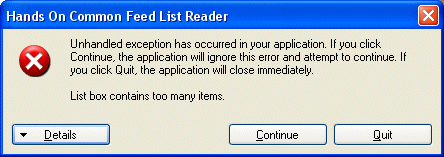If error messages told you what was really wrong, developer and admin productivity would soar.
I lost hours of my life over a problem with ntbackup. The error message was “C is not a valid drive or you do not have access”. Three different Microsoft support engineers gave it their attention, but we never identified the true problem. The drive was valid, of course, and the user had full local admin rights.
More recently I was working on my Common Feed List blogreader and hit this unusual error:

Hmm, “Listbox has too many items” – yet the error fired on the 8th item being added. After scratching my head for a few minutes, I figured out the problem: a blog with items that have an empty title element. It’s an atom feed, and the XML looks like this:
<title mode="escaped" type="text/html"/>
The IE7 RSS Platform API converts this to a null value in the item’s Title property. I was trying to render this as a string in the list box. Poof.
Digression: should the RSS Platform treat the empty element as null, or as an empty string? XML is not good at making this distinction. Since the title element in this case is present, but empty, I tend to the view that it should be an empty string; but others more expert may disagree.
So I fixed the code to check for null and convert it to an empty string and all was well. No thanks to the error message.
Tim,
Did you ever get your ntbackup problem resolved? I finally found that M$ has a hotfix for this:
http://support.microsoft.com/default.aspx?scid=kb;en-us;817688
And dug around until i found it for download on HP’s site (because I didn’t want to waste more time, and possibly money, on M$ support)
http://h71028.www7.hp.com/enterprise/downloads/WindowsServer2003-KB817688-i386-ENU.exe
take care,
–arthur
Actually that hotfix didn’t work for us, though it is definitely worth a try. It seems that the error can have several different causes.
Tim